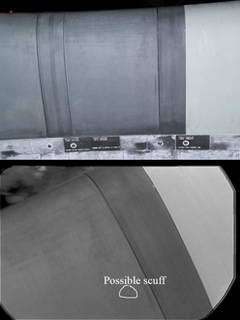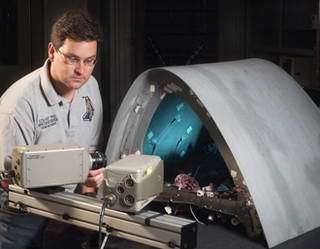Damage Detectives Inspect Shuttle on Orbit

When the shuttle Discovery streaked into the clear, blue sky this summer, millions of Americans sat on the edges of their seats, staring in awe at computer screens and television sets.
Image: When screeners compared the on-orbit photo (below) of this wing panel to the pre-flight photo (above), they saw a small white spot and flagged it as a possible scuff. Reinforced carbon-carbon experts later determined that the panel was not damaged. Credit: NASA
More than 100 ground and shuttle-based cameras offered unprecedented views as the orbiter climbed through the atmosphere, jettisoned its rockets and freed itself from the external tank.
But these elaborate camera systems were designed to do more than dazzle home viewers. They played a vital role in helping NASA determine whether the crew was safe to return to Earth. While viewers watched mission highlights like Discovery's back flip, teams of experts at various locations meticulously inspected images of the shuttle.
In a dim, windowless room called the Payload Operations Control Center, damage screeners, image analysts and thermal protection system experts scrutinized pictures of the shuttle's nose cap and wing leading edges.
These "damage detectives" came to the Mission Control Complex in the Johnson Space Center from NASA centers across the country to lend their expertise.
"We worked around the clock in shifts," said screener Duane Revilock, who eyeballed images from 6 p.m. to 3 a.m. "It took four days to do the screening."
The outer surfaces of the nose cap and wings are made of reinforced carbon-carbon, an insulating material that shields shuttle components from intense heat during lift-off and re-entry. Damage to this essential heat shield caused the shuttle Columbia to break apart upon re-entry in 2003.
To prevent such an accident from ever happening again, NASA equipped each of Discovery's wing leading edges with 66 accelerometers, which monitor the time and location of any debris impact, and 22 temperature sensors.
Shuttle engineers also added the Orbiter Boom Sensor System, an extension that attaches to the end of the shuttle's robotic arm and doubles its length to 100 feet. Discovery's crew used the boom to reach around the orbiter and scan the reinforced carbon-carbon surfaces with a Laser Dynamic Range Imager. Made by Sandia labs, this advanced imaging system captures sequences of video frames that can be viewed as normal pictures or combined to create three-dimensional images.

Image right: Revilock sets up a high-speed digital camera in Glenn's Ballistics Impact Laboratory to aid in testing the orbiter leading edge. Credit: NASA
Those video streams appeared in the Payload Operations Control Center, where screeners worked day and night in three shifts, inspecting every inch of the nose cap and wings for the most subtle signs of damage.
"The entire reinforced carbon-carbon surface was screened twice," said Michael Rollins, the lead image analyst for screening. "The screeners took their responsibility very seriously, as if their own children were on board."
The team members came from various backgrounds: some were orbital debris specialists, some were imaging experts, and others specialized in thermal structures. As an engineer at NASA Glenn's Ballistics Impact Lab, Revilock was familiar with damaged reinforced carbon-carbon. He spent more than two years shooting foam and ice at orbiter wing panels to determine the material's tolerance.
Photos of flat test wing panels shot in Glenn's Ballistic Impact Lab were among those Rollins used to train the screeners. "The flat test panels were a major asset in training," Rollins said. "They showed damage features that were very similar to what we were looking for on orbit."
During the mission, the screeners compared in-flight images to photos of the orbiter that were taken before flight and flagged any differences. Then, two reinforced carbon-carbon experts reviewed the flagged panels to determine if they represented damage.
"I was surprised by what the team was able to find," Rollins said. "I think the lives of the astronauts were in very good hands."
Though the screeners flagged approximately 130 small scuffs, spots and skid marks, none of them turned out to be cracks in the reinforced carbon-carbon. Discovery landed safely at Edwards Air Force Base on August 9 after a very successful mission.
"Until this, leading edges had never been screened in space for damage," Revilock said. "This was a test mission to try out new techniques, and NASA gained a lot of data to make sure future missions will be safer."
by Jan Wittry (SGT, Inc.), NASA's Glenn Research Center
















